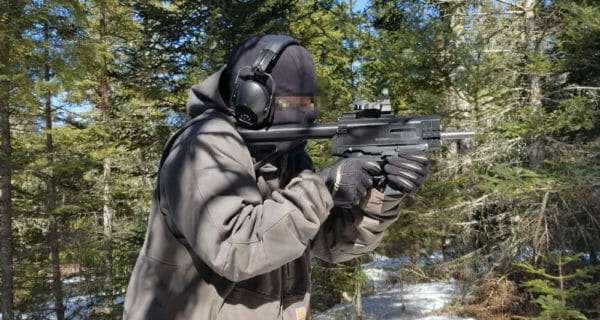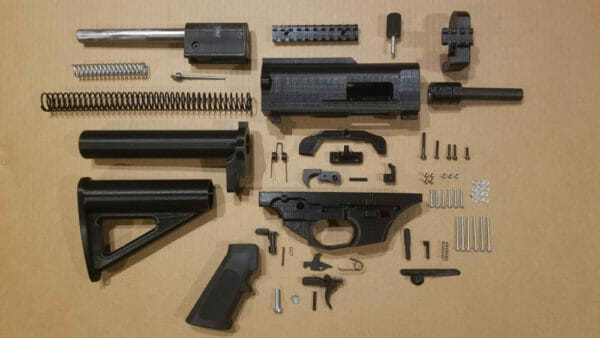U.S.A. –-(AmmoLand.com)- The FGC-9 design is a homemade, semi-auto, 3D printed, polymer 9mm carbine, for $600 in parts and tooling, and a two week build time.
Two weeks is less time than it takes to assemble the paperwork necessary to apply for a gun permit in most countries if gun permits are even accessible.
None of the parts or tools are “gun” specific. They are available over the counter or over the Internet, in most parts of the world. The FGC-9 gives a performance comparable to many commercially made pistol caliber carbines. Accuracy is claimed to be as good or better than Glock pistols.
3D Printed FGC-9 Carbine
Cautionary Note: The FGC-9, as pictured below and in the video above, has a shoulder stock and a barrel less than 16 inches long, which I believe makes it a short-barreled rifle, which requires a $200 tax stamp from the BATFE in the USA. I caution U.S. readers not to produce one with a rifle shoulder stock unless you fill out a Form 1 pay the tax and acquire the proper paperwork. Without the shoulder stock, FGC-9 should meet the requirements for a legal pistol, in our personal opinion. If a arm brace like the SBA3 Pistol Stabilizing Brace was substituted for a rifle shoulder stock, it should meet the requirements to be a legal pistol. Any time you are breaking new ground in the world of firearms development, especially when it involves new technologies, we caution you to get the best legal advice in navigating and lawfully complying with the multiple and confusing world of local, state, and federal gun laws. The only stated purpose of this article is to report on new developments and the adaption of new technologies for personal gunsmithing. Note to government agencies AmmoLand News does not host any of the embedded files or videos in this article.
The stock of the FGC-9 can easily be removed and is not necessary for the firearm to function.

I have written, previously, the future of 3D printed firearms will be in hybrid designs that utilize existing metal shapes and use 3D printing to produce the more complex and precise shapes needed to make effective homemade and small shop firearms.
Ivan the Troll demonstrated how to make a rifled barrel with electrochemical machining. The electrochemical machining of a barrel, combined with a hybrid 3D printed design and the use of existing, commercially available, over the counter or over the internet gun parts, have been combined by researcher, JStark1809, to produce a semi-automatic, 9mm, carbine design, the FGC-9.
FGC-9 is an acronym for F*ck Gun Control Nine. The cost for all tooling and materials including printer to make the semi-automatic, 9mm carbine, is less than $600. Each additional carbine costs less than $100 in materials. The carbine can be produced by a novice gunsmiths in two weeks or less.
Costs will be reduced if the maker already has some basic tools such as a drill press, a small welder, a socket set, and files. Many tools can be found on the used market for reasonable prices or on Amazon.
JStark1809 has created a documentation package which includes a do it yourself instruction set. It was created so anyone who can read English and follow directions, can acquire the modest tools and skill set needed and produce the FGC-9, in less than two weeks.
JStark1809 gives an 8-day timeline to produce the FGC-9. The time does not include making the barrel. Instructions for making the barrel are included in the package. It appears a barrel can be made in 1 to 2 days, which would give enough time for a mistake and correction or two.
Here is a link to an uncensored video interview with Deterrence Dispensed about the history and design of the FGC-9. The video is on lbry.tv, is one hour and 43 minutes in length, and gives extensive detail on what it takes to make the carbine. Warning – considerable expletives are used in the video, which was produced live by Anarchast.
Much of the success of the 3D printed FGC-9 firearm design comes from the use of off-the-shelf materials and existing technology. The magazine (the most important part of a semi-automatic firearm system) is either a commonly available Glock brand magazine, or a 3D printed copy of a Glock like magazine using springs ordered over the Internet. The 3D printed magazines cost less than $3 each in materials. They are said to be reliable for several hundred rounds.

The fire control system used is the AR-15 fire control system, easily purchased over the Internet, or a slightly modified air-soft fire control system, purchased over the Internet.
The design takes elements of successful firearms and combines them in ways specifically adapted to maximize the strengths of both 3-D printing and commonly available metal shapes and tools.
The ejector system is a nice bit of engineering. There is no hook to pull the cartridge from the chamber. The pressure from the cartridge being fired pushes it back against the bolt face. As the bolt retracts, in a simple blowback system, the bolt activates a lever that pops the empty case out of the ejection port. The video shows it working well.
A small amount of welding is required. Small welders are cheap and easy to obtain. The welding is simple and straightforward. Once the first bolt is made, the skills will have been learned. Welding is a widely known skill set. It would not be difficult for a person to have the welding done at a shop. That would sacrifice some operational security. Alternatively, a friend who knows how to weld, could do the simple welds required, in a few minutes.
Security is not much of a problem in the United States, where the Second Amendment and a tradition of firearms ownership have made firearms parts cheap, legal, and easy to obtain without paperwork.
In most of the world, firearm parts have become contraband for ordinary people. In Australia, merely possessing the digital files used to produce a firearm replica, is a crime.
Sustainable FGC-9 Carbine Production
The strength of the FGC-9 Carbine is it can be produced by an individual, at home, even in a small apartment, if electricity and access to the Internet are available. It is a proven design which only takes a couple of weeks to produce. Most of the time is taken by the 3D print process, which takes little skill or oversight.
For a small organization or shop, producing multiple copies of the FGC-9 takes minimal organization. One person needs to have basic 3D printing skills. One person needs to be able to produce simple welds. One person needs access to purchase materials over the Internet.
For an outlay of a couple of thousand dollars, and a five-meter by five-meter (16 x 16 ft) space with electricity, a small shop with two or three workers could produce 3-4 complete FGC-9 carbines a week. The limit would be the print time on the 3-D printers. Half a dozen 3D printers would not take up much space and would add flexibility and redundancy. Add another half a dozen 3D printers for another $1,500, and increase the production to one FGC-9 per day. Very little hand fitting is required.
Once mastered, 10 barrels for this application could be produced by one person in a day.
The dimensional stability in the 3D printing process is such that parts could be produced in runs and stockpiled for assembly line production.
A 9-millimeter carbine is a logical and useful firearm to produce. It is only slightly more difficult to produce silencers for such a firearm. A small lathe would make silencer production and the threading of the barrels relatively easy. A capable lathe can be purchased for under $1,300.
9 mm cartridges are available all over the world and the 3D producible firearms design can be adapted to other calibers and magazines.
Small shop-made or homemade sub-machine guns are being produced all over the world. The FGC-9 is a reliable alternative that requires far less hand fitting and is far more accurate. Most homemade sub-guns do not use rifled barrels. In Australia, similar black market guns are sold for $5,000 each.
I suspect the FGC-9 Carbine will soon be seen in Australia, Canada, Brazil, Europe, India, Israel, Nigeria, Pakistan, and the Philippines. It may be seen in New York City, Los Angeles, and Chicago.
You can’t stop the signal.
About Dean Weingarten:
Dean Weingarten has been a peace officer, a military officer, was on the University of Wisconsin Pistol Team for four years, and was first certified to teach firearms safety in 1973. He taught the Arizona concealed carry course for fifteen years until the goal of Constitutional Carry was attained. He has degrees in meteorology and mining engineering and retired from the Department of Defense after a 30-year career in Army Research, Development, Testing, and Evaluation.
